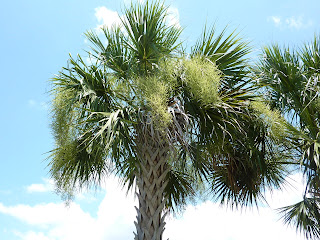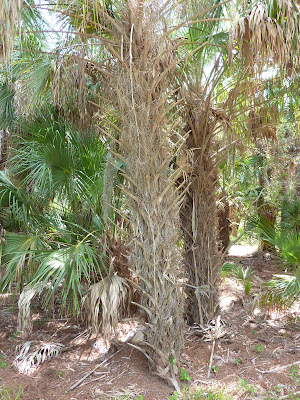 |
| Cabbage Palm Grove |
I’m not sure why we have an official Florida “State Tree”, but we do. It is the Cabbage Palm. One would expect that earning this title would place this palm on an honored and respected plane akin to the Bald Eagle or the Giant Sequoia, as it rightly should. But quite the opposite is true. The Cabbage Palm, mainly because of its hardiness, or perhaps its name, gets no respect. In spite of its truly tropical appearance, landscape architects tend to shun the species in favor of more exotic ones. Virtually all other species of palm command higher prices as a landscape item. (Customer snob appeal enters the picture. Would you prefer to plant a “Silver” Palm, a “Royal” Palm, a “Washington” Palm, or a “Cabbage” Palm?) Vast acreages of cabbage palms are lost every year through slash and burn clearing for suburban homes sites and new shopping. Fortunately, the palm is not endangered or threatened at this time.
The Cabbage Palm is found naturally in all parts of Florida. Also known as the Sabal Palm, Palmetto Palm, or Sabal Palmetto, it is a survivor. Fossils have been found of Cabbage Palm fronds from 60 million years ago. It is extremely heat, cold, and draught and salt tolerant. The name Cabbage Palm comes from the edible and delicious heart of palm, or “cabbage” located at the top from where new growth develops. Unfortunately, harvesting the heart kills the tree and is banned in the US. The Cabbage Palm is quite prevalent in some areas, with large forests consisting primarily of these palms. The flowers are yellowish-white, produced in large compound panicles up to 8 ft long, extending out beyond the leaves. Its fruit is a black berry about .5 in long containing a single seed.
But is the Cabbage Palm really a tree? Trees are classified as either Angiosperms (flowering plants), or Conifers (cone bearing). All Palms are Angiosperms. However, unlike most other trees, they are members of a group called monocots, which produce seeds containing only one leaf. They are much closer related to wheat, rice, barley, sugar cane, bamboo and grass, than to oak or pine trees. The largest family in this group (and in angiosperms as a whole) is the orchid. But “tree” is not a scientific term. “Tree” generally means a woody plant, with a single trunk, and a minimum height at maturity of 12 feet or more. So the cabbage palm does indeed meet the tree definition.
 |
| Cabbage Palm in Full Bloom |
 |
| Cabbage Palm Flowers |

Countless species of fauna and flora depend upon the Cabbage Palm for shade, protection and nourishment. Black bear, raccoons, bats, wild turkeys, white-tailed deer, gulls, cardinals, grackles, blue jays, and scrub jays all rely on the fruit for food. As with most trees, the largest group of animal inhabitants is birds. Birds of many species will temporarily perch on a high frond while scouting food and predators. Many will build a nest in the top center where new fronds create a natural protected area.

But the features that set the palm apart from all other trees and provide a unique habitat are the “bootjacks”. As the palm grows, new fronds sprout from the top where the heart is located. Old fronds below eventually die and turn brown. (A palm with dead fronds hanging down is said to be “bearded”.) The lower of these will then break off, leaving the y shaped base of the frond still attached to the main trunk. These are called bootjacks. A small cavity, about the size of a small orange, exists where the boot meets the trunk. A typical palm will have hundreds of these micro dwellings. Debris, in the form of dead leaves, pine needles, and airborne detritus and seeds will collect in many of these pockets. Add abundant rain in the summer and you’ve got a nursery for hundreds of flowers and plants. Small rodents, reptiles, birds and insects find this a made-to-order nest.
 Most of this symbiotic growth will die in the fall, when the dry season ceases the supply of rainwater. But a large group of epiphytic plants, vines, and mosses survive in these pockets indefinitely. Most typical are air plants and ferns. This growth can become very dense and some palms will appear as if they are actually sprouting bushy new growth all up and down the trunk.
Most of this symbiotic growth will die in the fall, when the dry season ceases the supply of rainwater. But a large group of epiphytic plants, vines, and mosses survive in these pockets indefinitely. Most typical are air plants and ferns. This growth can become very dense and some palms will appear as if they are actually sprouting bushy new growth all up and down the trunk. When a cabbage palm is transplanted for use in landscaping, it is heavily pruned, root cropped and usually de-booted. This produces an odd looking stalk, with a small root ball and a few wisps of greenery on top.
Surprisingly, most transplants survive. A tree can obtain a height of 80 feet or more, although 40 to 60 feet is most common. Some Cabbage Palms in natural surroundings will lose all their boots and the trunk will appear smooth. Some will keep all their boots and some will be partially booted. This appears to be a random phenomenon, and poorly understood. Tree health, environment, location and wildlife activity may be factors. Another unusual characteristic of the palms is their growth pattern. They will achieve almost full trunk diameter while still only 2 to 3 feet tall! The outer “bark” is dead and all future growth will be vertical.
With all these variations in size and appearance, it is easy to misidentify. Florida has only eight native palms species (but many more imported exotics). “Native” is another term like “tree” that has a somewhat loose definition. A US “Native” plant is defined by Wikipedia as a plant that has been growing here since before colonization.
To ID a Cabbage Palm look for the fan shaped 6 foot leaves, which distinguish it from the Royal Palm which has huge 15 to 20 foot leaves. And there is a lack of a saw edge on the frond stalks. This will distinguish it from the much shorter Saw Palmetto. The smaller Buccaneer Palm will have rings on the lower trunk and the Everglades Palm grows in clumps. The Florida Thatch Palm and Keys Thatch Palm will have rounded and folded leaves. And lastly, the Needle Palm is a low growing palm with 4 -8 inch needle like spines produced between leaves. (All other palm varieties have been imported from tropical and sub tropical lands.) But if you forget all these characteristics, just play the odds. If you’re in Florida, and in the wild, and see a palm, the chances are pretty good it’s a Cabbage Palm.

No comments:
Post a Comment